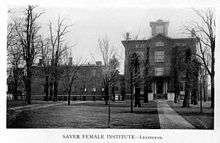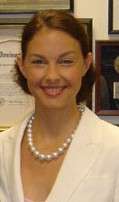Sayre School
Sayre School is an independent, co-educational school in Lexington, Kentucky. The school enrolls 563 students from preschool to twelfth grade. It has 68 full-time faculty members.[3]
| Sayre School | |
|---|---|
 | |
| Location | |
| , United States | |
| Coordinates | 38.048°N 84.494°W |
| Information | |
| Type | Independent |
| Motto | "Make Your Mark." |
| Established | 1854 |
| Head of School | Stephen Manella [1] |
| Enrollment | 603 total (PS-12)[2] |
| Average class size | 15 students[3] |
| Student to teacher ratio | 7:1 |
| Campus | Urban; 10 buildings[4] |
| Athletics | 40 sports teams offered at the Varsity, Junior Varsity and Middle School level(grades 6-12)[5] |
| Mascot | Spartan |
| Website | sayreschool |
History
David A. Sayre, a New Jersey silversmith, migrated to Lexington where he eventually became a successful banker. He and his wife Abby founded the school as an all female boarding school in November 1854 when he met with a group of businessmen met in the offices of former Kentucky Secretary of State George B. Kinkead with several other prominent members of the "McChord" (now First) Presbyterian Church including John C. Breckinridge, drew up the articles of incorporation.[6] Originally named the Transylvania Female Seminary, the school opened first in the old Bank of the U.S. building on the corner of Mill and Church and the Presbyterian minister, Rev. Henry V.D. Nevius was appointed as principal.
In the fall of 1855 the school was moved to its current location on Limestone Street (see the National Register of Historic Places information[7] about the expansion of the original building), and the trustees changed the name to the Sayre Female Institute. The Kentucky General Assembly granted its charter in 1856 to confer collegiate degrees.
The school remained an all female boarding school until 1876 when boys were admitted as day scholars in the primary grades under the leadership of Major Henry B. McClelland,[8] principal from 1870 to 1904. In 1914, the nearby preparatory school of Miss Ella M. Williams merged with Sayre, and the name was changed to Sayre College and Conservatory of Music. During the Great Depression, the school struggled, but in 1942 it grew with the incorporation of the Hamilton Grammar School, and changed its name to Sayre School, dropping its collegiate degree program.[6] The pillars outside the main entrance of the campus still show "Sayre College." In 1947 the high school grades were discontinued and the boarding rooms were leased to the University of Kentucky ended. In 1961 an English teacher from Lafayette High School, Donn D. Hollingsworth was appointed headmaster and the high school was resumed in addition to the grammar school, beginning the "New Era."[9]
Academics
The Sayre School consists of three academic divisions, covering ages 2 through grade 12. The Lower School consists of a preschool program, for ages 2–5,[10] and Kindergarten through Grade 4. The Middle School covers grades 5-8, and the Upper School has grades 9-12, like a traditional high school. The Upper School offers 17 Advanced Placement courses, and 85% of seniors who took an AP class earned a score of 3 or higher with 60% being designated as AP Scholars; two were National AP Scholars.[11]
People
Since Sayre is no longer a boarding school, most of its students reside in Lexington, Kentucky or its nearby counties, such as Scott County, Bourbon, Jessamine, Madison, and Woodford counties. Students come from 15 Central Kentucky counties, such as Fleming and Estill counties, that are more than an hour commute away.[3]
Tuition
The school is the most expensive college preparatory institution in the Bluegrass region,[12][13] charging $9,095 to $22,050 a year for tuition.[14] Tuition rates increase with the level of education, meaning that Sayre charges students in its high school, or Upper School, the most. The school offers both need-based financial assistance and merit scholarships.
Notable alumni

Notable past Sayre students include Nobel Laureate William Lipscomb,[15] woman suffragist Laura Clay, settlement school founder Katherine Pettit, Josh Hopkins, Mayor Thomas E. Hayden of Flower Mound, Texas,[16] Mr. Joshua L. Bishop, Byrd Spilman Dewey and actress Ashley Judd.[17][18]
Athletics
Sayre's sports teams are called the Spartans. Their school colors are blue and gold. Notably, the school has a "no-cut" policy for its sports teams, meaning that any student can participate on an athletic team, regardless of ability, if he or she wishes to do so.[5] Sayre School's Upper School sports teams include boys' and girls' soccer, boys' and girls' lacrosse, boys' and girls' basketball, coed tennis, coed swimming, boys' and girls' golf, coed diving, coed cross country and track, along with boys' baseball and girls' volleyball. Football was reintroduced in 2018 and is coached by former NFL quarterback Chad Pennington. These sports are all a part of the Kentucky High School Athletic Association (KHSAA) and compete in the "All A" conference which is a mid-season statewide tournament.
References
- "Sayre: Headmaster's Welcome". sayreschool.org. Retrieved 2012-08-08.
- "Fast Facts". sayreschool.org. Retrieved 2015-10-22.
- "Sayre: Fast Facts". sayreschool.org. Retrieved 2015-10-22.
- "Sayre: Campus Map". sayreschool.org. Retrieved 2008-01-16.
- "Sayre: Athletics". sayreschool.org. Retrieved 2012-06-23.
- Coleman, J. Winston (1954). A Centennial History of Sayre School, 1854-1954. Lexington: Winburn Press. Retrieved 13 December 2016.
- "Sayre Female Institute". National Register of Historic Places Inventory. U.S. Department of the Interior, National Park Service. 10 February 1982. Retrieved 13 December 2016.
- Louisville Courier Journal. April 24, 1904, p. 4
- Grunwald, Thomas. "Founder's Day Tidbits" (PDF). Sayre School. Retrieved 13 December 2016.
- "Preschool". sayreschool.org. Retrieved 2015-10-22.
- "Fast Facts". sayreschool.org. Retrieved 2016-09-26.
- "Tuition and Fees: Lexington Catholic High School". lexingtoncatholic.com. 2016. Retrieved 2016-09-26.
- "Tuition and Fees". lexingtonchristian.org. 2016. Retrieved 2012-09-26.
- "Tutiton and Fees". sayreschool.org. 2016. Retrieved 2012-09-26.
- Chapter: Process of Discovery (1977); An Autobiographical Sketch, William Lipscomb, 14 pp., Sayre is on page xv, in the book Structures and Mechanisms: From Ashes to Enzymes (Acs Symposium Series, vol. 827) Gareth R. Eaton (Editor), Don C. Wiley (Editor), Oleg Jardetzky (Editor), American Chemical Society, Washington, DC, 2002, ISBN 9780841237360, 404 pp., online at pubs.acs.org.
- "Thomas Edward Hayden". intelius.com. Retrieved February 3, 2014.
- "Interview Ajudd; Tops in Lex". topsinlex.com. Retrieved 2007-12-19.
- "Educators: Katherine Pettit". Women in Kentucky. Retrieved 2008-03-24.